
Otranto is a coastal town, port and comune in the province of Lecce, in a fertile region once famous for its breed of horses. It is a member of the I Borghi più belli d'Italia association.

Brindisi is a city in the region of Apulia in southern Italy, the capital of the province of Brindisi, on the coast of the Adriatic Sea. Historically, the city has played an important role in trade and culture, due to its strategic position on the Italian Peninsula and its natural port on the Adriatic Sea. The city remains a major port for trade with Greece and the Middle East. Its industries include agriculture, chemical works, and the generation of electricity.

Messapic is an extinct Indo-European Paleo-Balkanic language of the southeastern Italian Peninsula, once spoken in Apulia by the Iapygian peoples of the region: the Calabri and Salentini, the Peucetians and the Daunians. Messapic was the pre-Roman, non-Italic language of Apulia. It has been preserved in about 600 inscriptions written in an alphabet derived from a Western Greek model and dating from the mid-6th to at least the 2nd century BC, when it went extinct following the Roman conquest of the region.

Lecce is a city in southern Italy and capital of the province of Lecce, with the second-highest population in the Apulia region. It is on the Salentine Peninsula, at the heel of the Italian Peninsula, and is over two thousand years old.

The Messapians were an Iapygian tribe who inhabited Salento in classical antiquity. Two other Iapygian tribes, the Peucetians and the Daunians, inhabited central and northern Apulia respectively. All three tribes spoke the Messapian language, but had developed separate archaeological cultures by the seventh century BC. The Messapians lived in the eponymous region Messapia, which extended from Leuca in the southeast to Kailia and Egnatia in the northwest, covering most of the Salento peninsula. This region includes the Province of Lecce and parts of the provinces of Brindisi and Taranto today.
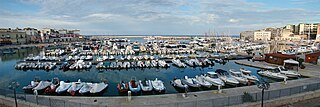
Bisceglie is a city and municipality of 55,251 inhabitants in the province of Barletta-Andria-Trani, in the Apulia region, in southern Italy. The municipality has the fourth highest population in the province and fourteenth highest in the region.

Pazzano is a village and comune located in Locride's region in the province of Reggio Calabria.
Miggiano is an Italian city of 3,702 inhabitants in the province of Lecce in Apulia. Located in the lower Salento, a few kilometres from the Adriatic coast, it lies 50 kilometres (31 mi) from the chief town and 22 kilometres (14 mi) from Santa Maria di Leuca. Formerly considered a town, in 2003 Miggiano was elevated to the status of City.
Santa Maria di Leuca, often spelled simply Leuca, is a frazione of the comune of Castrignano del Capo, in the Salento peninsula (Apulia), southern Italy. A part of the town once belonged to the comune of Gagliano del Capo.
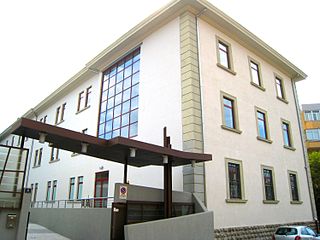
Civico Museo di Storia Naturale di Trieste is a natural history museum in Trieste, northern Italy. It contains several collections, including more than two millions botanical, zoological, mineralogical, geological, and paleontological specimens.
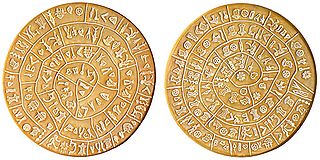
Luigi Pernier was an Italian archaeologist and academic now best known for his discovery of the Disc of Phaistos.

The Nuragic civilization, also known as the Nuragic culture, was a civilization or culture on the Mediterranean island of Sardinia, Italy, which lasted from the 18th century BC up to the Roman colonization in 238 BC. Others date the culture as lasting at least until the 2nd century AD and in some areas, namely the Barbagia, to the 6th century AD or possibly even to the 11th century AD.
Coppa Nevigata is an archaeological site in the province of Foggia, southern Italy, southwest of Manfredonia, on the Apulian coast of the Gargano peninsula.
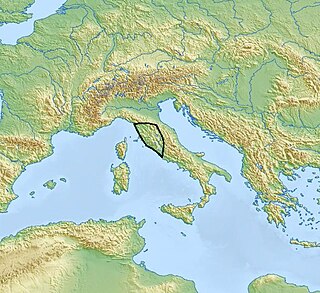
The Rinaldone culture was an Eneolithic culture that spread between the 4th and the 3rd millennium BC in northern and central Lazio, in southern Tuscany and, to a lesser extent, also in Marche and Umbria. It takes its name from the town of Rinaldone, near Montefiascone in the province of Viterbo, northern Lazio.
Ettore Gabrici was an Italian archaeologist and numismatist.

The Arene Candide, is an archaeological site in Finale Ligure, Liguria, Italy. Its name was derived from the eponymous dune of white (candida) sand (arena) that could be found at the base of the cliff until the 1920s in the Caprazoppa promontory, where the Arene Candide cave is located.

The Deer Cave is a natural cave at the Salento coast near the town of Porto Badisco, around 8 km (5.0 mi) south of Otranto in Apulia, Italy. Unknown before 1970, it came to immediate international attention after the discovery of its impressive, innovative and enigmatic complex galleries of prehistoric parietal wall paintings.
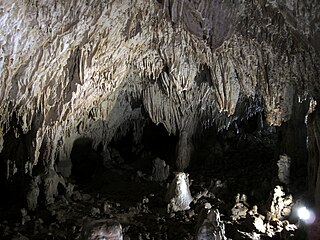
The Romito cave is a natural limestone cave in the Lao Valley of Pollino National Park, near the town of Papasidero in Calabria, Italy. Stratigraphic record of the first excavation confirmed prolonged paleo-human occupation during the Upper Paleolithic from 17,000 years ago and the Neolithic from 6,400 years ago. A single, but exquisite piece of Upper Paleolithic parietal rock engraving was documented. Several burial sites of varying age were initially discovered. Irregularly recurring sessions have led to additional finds, which suggests future excavation work. Notable is the amount of accumulated data that has revealed deeper understanding of prehistoric daily life, the remarkable quality of the rock carvings and the burial named Romito 2, who exhibits features of pathological skeletal conditions (dwarfism).
Rudiae, was a former late 9th or early 8th centuries BCE human settlement. It is presently an archaeological park beside the San Pietro in Lama that runs south-west from the city of Lecce. The place was identified as the former home of the poet Ennius by the Renaissance Humanist, Antonio de Ferraris.
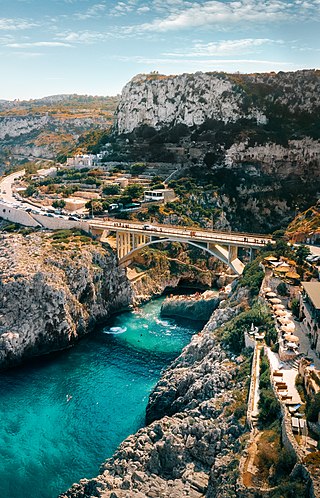
Ciolo is a narrow coastal inlet and a site of historical and environmental interest, which is located in Apulia, Italy. The location is also known as a geological site and for the presence of numerous sea caves, the largest one being the Grotta del Ciolo. Since October 2006 the Ciolo's area has become part of the Regional Park "Costa Otranto - Santa Maria di Leuca e Bosco di Tricase", created by the Apulia region to protect the eastern coast of Salento, specifically the architectural assets as well as important animal and plant species.

















